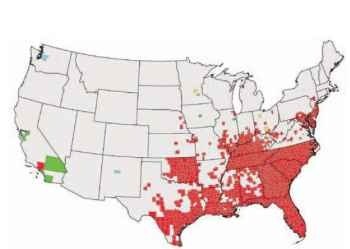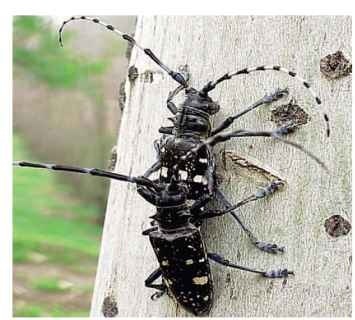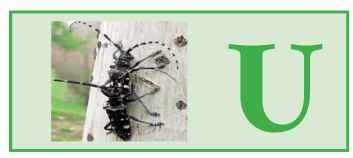Urban environments are created from natural or agricultural ecosystems that have been disturbed by human activities, typically by the construction of towns and cities. The urban biotic environment can be divided into plant and animal communities that surround houses and buildings, occur indoors or in close contact with humans, or directly affect the structure. Human activities give rise to special conditions and environments that are frequently exploited by a select group of insects and arthropods. For example, about 25 species of the some 3500 known cockroaches are considered to be domicilary pests. Of these 25 species, only about 5 are considered to be serious urban pests. Similarly, of the approximately 550 species of ants found in the United States, only 30 species commonly infest homes, and only 10 of these are of major importance. Urban landscapes are truly special ecological environments and niches.
Urban environments are similar in developing and developed countries worldwide in that natural systems have been disturbed by human activities. The rate at which urbanization is occurring in undeveloped areas of Africa, South America, and Asia is almost incomprehensible. By the year 2025, 6.3-8 billion people will inhabit less developed regions of the world compared with 1.2- 1.5 billion people that will inhabit the developed regions. Between 1960 and 1990, the number of cities in China, Indonesia, and Brazil with more than 500,000 residents doubled; in India, the number tripled. By the year 2010, about 57% of the world’s population will be living in urban centers, and in Brazil, it will be close to 89%. Because of the rapid growth of urban cities in developing countries with tropical climates, urban insect pests, especially those that vector human and animal disease pathogens, are a critically important emerging problem.
DEVELOPMENT OF MEGACITIES
A newly emerging feature of countries with large population centers is the development of mega urban cities. Megacities typically incorporate two or more large urban centers linked by transportation. Rural zones between such megacenters are characterized by commercialization of agriculture, expansion of transport systems, and employment shift from farming to other activities, accompanied by migration to the cities. The number and size of these megacities in developing countries will continue to grow, and by 2015 it is projected that there will be some 23 megacities with more than 10 million inhabitants (Table I). Tremendous amounts of resources and commerce will be necessary to support the large populations and the waste and garbage they will produce. It is these conditions that are conducive to insect pest problems such as mosquitoes, flies, cockroaches, fleas, termites, and wood-destroying pests. In addition, crowding and waste lead to vertebrate pest problems such as rats, mice, and pigeons.
Urban centers require the movement of goods and food to maintain their large human populations. Human movement and transportation of commerce provide a unique and rapid dissemination of insects and arthropods between centers. At the turn of the 20th century, it took over a week for ships to sail from Europe to North America. Today aircraft make the same journey in less than 7 h. The potential exists for rapidly spreading insects and the diseases they vector from one continent to another. Three recent examples of urban invasive species spread by commerce are presented.
URBAN INVASIVE SPECIES
Asian Tiger Mosquito
It is thought that the Asian tiger mosquito, Aedes albopictus, entered the United States in Houston, Texas, in 1985 in used automobile tires imported from northern Asia. Ae. albopictus is a major human-biting pest species throughout its range. In addition, it has been experimentally shown to be a competent vector of a number of viruses including Western equine encephalitis, dengue, Japanese encephalitis, and yellow fever. To highlight the impact of commerce on the potential movement of insect pests, over 11 million used tires from 58 different countries entered the United States from 1978 to 1985. Ae. albopictus also shows the importance of local transport and the interstate highways. In 1987, of the 92 counties infested with this species, 64 were on an interstate highway, nearly twice the number that would be expected if their spread were not related to these road systems.
Since its introduction, this mosquito has spread to 25 states, mostly throughout the southeastern United States but as far north as Iowa, Illinois, and Ohio (Fig. 1). The female’s propensity to lay eggs in bottles, cans, tires, rain gutters, flower pots, watering cans, children’s swimming pools, and containers makes this mosquito ideally suited for urban environments.
Formosan Subterranean Termite
The Formosan subterranean termite, Coptotermes formosanus, has spread by marine commerce to semitropical and tropical seaports throughout the world. Once ashore, railroad ties provide a rapid method of moving and establishing large colonies of termites. In the 1960s, C. formosanus was discovered in Texas, Louisiana, and South Carolina. By 2000, it had spread to nine other southern states, and to California and Hawaii. C. formosanus is characterized by extremely large populations of aggressive foragers that can do extensive damage to structures. It is the most import urban pest in Hawaii and has been estimated to cause about $300 million damage a year in New Orleans, threatening nearly all the buildings of the historic French Quarter.
TABLE I |
|||||
| Emerging Megacities of the World with More Than 10 Million Inhabitants (Population in Millions) | |||||
| 1975 | 2000 | 2015 | |||
| City | Population | City | Population | City | Population |
| Tokyo | 19.8 | Tokyo | 26.4 | Tokyo | 26.4 |
| New York | 15.4 | Mexico City | 18.1 | Bombay | 26.1 |
| Shanghai | 11.4 | Bombay | 18.1 | Lagos | 23.2 |
| Mexico City | 11.2 | Sao Paulo | 17.8 | Dhaka | 21.1 |
| Sao Paulo | 10.0 | Shanghai | 17.0 | Sao Paulo | 20.4 |
| New York | 16.6 | Karachi | 19.2 | ||
| Lagos | 13.4 | Mexico City | 19.2 | ||
| Los Angeles | 13.1 | Shanghai | 19.1 | ||
| Calcutta | 12.9 | New York | 17.4 | ||
| Buenos Aires | 12.6 | Jakarta | 17.3 | ||
| Dhaka | 12.3 | Calcutta | 17.3 | ||
| Karachi | 11.8 | Delhi | 16.8 | ||
| Delhi | 11.7 | Metro Manila | 14.8 | ||
| Jakarta | 11.0 | Los Angeles | 14.1 | ||
| Osaka | 11.0 | Buenos Aires | 14.1 | ||
| Metro Manila | 10.9 | Cairo | 13.8 | ||
| Beijing | 10.8 | Istanbul | 12.5 | ||
| Rio de Janeiro | 10.6 | Beijing | 12.3 | ||
| Cairo | 10.6 | Rio de Janeiro | 11.9 | ||
| Osaka | 11.0 | ||||
| Tianjin | 10.7 | ||||
| Hyderabad | 10.5 | ||||
| Bangkok | 10.1 | ||||

FIGURE 1 Current distribution of Aedes albopictus in the United States: red, positive counties; yellow, negative/eradicated/disappeared; blue, intercepted (never established); green, current status unknown.
Asian Long-Horned Beetle
The Asian long-horned beetle, Anoplophora glabripennis ( Fig. 2 ), has the potential of becoming a serious pest of ornamental trees found in urban landscapes. Infestations of Asian long-horned beetle were first discovered in 1996 in Brooklyn. Another infestation was found in Chicago in 1998. It is believed that the beetle entered the United States in solid wood packing material from China. The beetle has been found in warehouses in some 26 locations throughout the United States. This beetle poses a serious threat to many different hardwood trees that are common in urban landscapes, including sugar, silver and red maple, birch, poplar, willow, ash, and black locust. The cost of suppressing the beetle in New York has already reached $4 million.
ADDITIONAL URBAN PESTS
The vast majority of insects, however, are not capable of adapting to the artificial and unnatural conditions created by humans in urban environments. A few pests such as the German cockroach, cat flea, and house fly have readily adapted, have been able to survive in close proximity to humans, and now are cosmopolitan. Many urban insect pests such as the German cockroach, oriental cockroach, confused flour beetle, and granary weevil have lost their ability to fly and rely on human activities for their dispersal. Other species such

FIGURE 2 A male and a female Anoplophora glabripennis on a poplar (Populus alba) tree.
as the Argentine ant and the pharaoh ant do not swarm and rely on budding for reproduction and commerce for transport. Many of the indoor pests of food and fabric have continuous development and do not require special dormancy or hibernation to complete development. These insects thrive at temperatures ranging from 18 to 35°C and relative humidity (RH) ranging from 50 to 90%, which are ranges typically found within human dwellings.
In addition to human occupants, domesticated pets may be a source of pests such as fleas, ticks, and mites. The cat flea, Ctenocephalides felis, is the most important ectoparasite of domesticated cats and dogs worldwide. From its probable origin in Africa, the cat flea has spread worldwide. In most urban environments, the larval development requirements of C. felis (RH > 75%, 21-32°C) are found in restricted microhabitats such as crawl spaces under homes, pet houses and bedding, utility rooms, and bedrooms. Interestingly, surveys of feral animals such as opossums indicate that C. felis is encountered only on animals frequenting urban settings.
NEED FOR URBAN PEST MANAGEMENT
The need for urban pest management in and around structures can be directly attributed to the dislike of insects and arthropods by humans. Some pests such as cockroaches, fleas, flies, and mosquitoes represent potential health risks. Others such as termites and wood-destroying pests can cause serious economic damage to structures. Pantry and fabric pests cause damage to foods, fabrics, and items made with furs, skins, and feathers. Many pests such as earwigs (Dermaptera), crickets (Orthoptera), pillbugs (Isopoda), sowbugs (Isopoda), and millipedes (class: Diplopoda) are occasional intruders, but their suppression often requires remedial action. The control of urban pests has created a large and important industry in the United States and Europe; in the United States alone about 1 million structures are treated each year for termite damage, repairs, and treatments at a cost of about $520 million.
The costs of treatment and repair by the pest control industry in the United States are estimated at about $2 billion. Consumers’ annual expenditures on over-the-counter pest control remedies probably are at least as much. In developing countries, there will be an increasing need for pest control to protect the health and welfare of the inhabitants. With the increasing levels of international trade and tourism, urban pest management will take on special importance in the 21st century.

